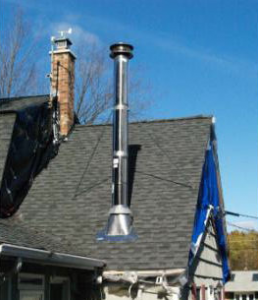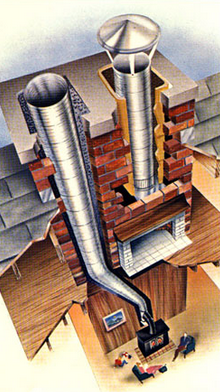Manufactured Chimney Products
In the case of freestanding wood and pellet stoves along with wood and pellet inserts, manufactured chimney is needed to properly exhaust these products.
When there is no chimney existing where a wood or pellet stove is to be installed, you will need to have a chimney installed. Rather than build a masonry chimney which can cost upwards of $20,000+ in some cases, we turn to a manufactured chimney.
In the case of wood burning chimney, we use a product known as Class A Chimney. This is specially designed pipe for close clearances. It’s insulated so that it only requires a 2″ clearance to combustible material. This allows us to pass through
a roof or out the wall and up the side of the house.
Inside the home, we use either a single wall or double wall smoke pipe to connect to the Class A Chimney. The single wall pipe can be used when clearances of 18″ or more are met. Inside of 18″ clearance to combustibles, double walled smoke pipe must be used. Double wall smoke pipe requires only a 6″ clearance to combustibles, and also offers a lifetime warranty.
Pellet stoves use a similar product called Class L Chimney, or L-Vent. While similar to Class A, L-vent only has a 1″ clearance to combustibles. Because pellet stoves have a low exhaust temperature, they can often be direct vented, which means vented directly through the wall to the outside of the home and capped off right there with no rise.
L-Vent runs either 3″ or 4″ depending on the size of the exhaust of the pellet stove, and is also able to exhaust vertically through a roof.
Chimney Liner
In the case of a fireplace insert, which is a wood or pellet burning stove that is designed to fit inside of a fireplace, a chimney liner is needed.
There are several reasons that a liner is needed when an insert is installed. The main reason is that it is needed to meet code. The fire code states that the size of the chimney cannot exceed 3x the square inches of the exhaust of the appliance. In almost every chimney, this rule is violated with an appliance, thus needing a liner.
One of the other key factors for a liner is that the stainless steel lining heats up quickly, and allows the exhaust gases to stay hot to the top of the chimney, reducing the buildup of creosote in the chimney. A liner is also needed in the case of cracked or missing flue tiles.

Our liner kits include the liner itself, which is a single, rolled length of stainless steel which will reach from the exhaust of the appliance to the top of the chimney. There is also an appliance adaptor, a top plate which seals off the top of the flue tile, a rain cap (if there is no pre-existing cap), and also a tee if necessary.
We use only the highest quality stainless steel liners for our installations, which offer a Manufacturer’s Lifetime Warranty.
Call today to discuss pricing for your job.



